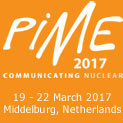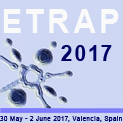Radioactivity
 scroll scroll 
Property of certain substances to convert without external
effect, emitting a characteristic radiation. Radioactivity was discovered
for uranium by Becquerel in 1896. If the substances, or to be more precise,
the radionuclides occur in nature, one refers to natural radioactivity;
if they are a product of nuclear conversions in nuclear reactors or
accelerators, one refers to artificial radioactivity. More than 2,750
radionuclides are known today. Each radionuclide is characterized by
its half-life, the time during which
half the atomic nuclei convert in a given quantity. Half-lives of several
billion years (uranium-238; even still longer-lived is tellurium-128
with a half-life of 7.2·1024 years) to the millionth
of a second (Po-212) are known. The radiation emitted during decay and
its energy is also characteristic. For example, radium-226 decays emitting
alpha radiation, while iodine-131 emits beta rays.
back
|
|
ENS conferences |
| |
 |
TopSafe 2017
12-16 Feb. 2017
Vienna, Austria |
 |
PIME 2017
19 - 22 March 2017, Middelburg Netherlands |
 |
RRFM 2017
14 - 18 May 2017 in Rotterdam, Netherlands |
 |
ETRAP 2017
30 May - 2 June 2017, Valencia, Spain |
|
|